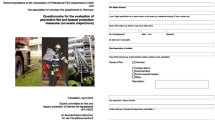Abstract
The calculation of normalized heat load, a succinct quantifier of the potential of compartment fires to spread by destruction, is greatly simplified by the introduction of two semi-empirical equations. These afford direct insight into the relation between the destructive potential of fire and the principal characteristics of the fire compartment and its contents of combustibles.
Similar content being viewed by others
References
Ingberg, S. H., “Tests of Severity of Building Fires,”NFPA Quarterly, Vol. 22, No. 1 (1928), pp. 43–61.
Harmathy, T. Z., “The Possibility of Characterizing the Severity of Fires by a Single Parameter,”Fire and Materials, Vol. 4, No. 2 (1980), pp. 71–76.
Harmathy, T. Z., “The Fire Resistance Test and Its Relation to Real-World Fires,” To be published.
Harmathy, T. Z., “Fire Severity: Basis of Fire Safety Design,” presented at International Symposium on Fire Safety of Concrete Structures, ACI Fall Convention, Puerto Rico, September 1980.
Lie, T. T., “Safety Factors for Fire Loads,”Can. J. Civil Engineering, Vol. 6, No. 4 (1979), pp. 617–628.
Thomas, P. H., “The Fire Resistance to Survive a Burn-Out,” Joint Fire Research Organization, England, Fire Research Note 901 (1970).
Law, M., “A Relationship between Fire Grading and Building Design and Contents,” Joint Fire Research Organization, England, Fire Research Note No. 877 (1971).
Law, M., “Prediction of Fire Resistance,” Symposium No. 5, Joint Fire Research Organization, Her Majesty's Stationery Office, London, England (1973), p. 16.
Pettersson, O., “Structural Fire Protection,” Lund Institute of Technology, Lund, Sweden, Bulletin 80 (1978).
References
Harmathy, T. Z., “A New Look at Compartment Fires, Parts I and II,”Fire Technology, Vol. 8, No. 3 and 4 (1972), pp. 196–217, 326–351.
Butcher, E. G., Chitty, T. B., and Ashton, L. A., “The Temperatures Attained by Steel in Building Fires,” Joint Fire Research Organization, England, Fire Research Technical Paper No. 15, 1966.
Butcher, E. G., Bedford, G. K., and Fardell, P. J., “Further Experiments on Temperatures Reached by Steel in Buildings,” Proceedings of Symposium held at Fire Research Station, January 1967, Joint Fire Research Organization, England, 1968, p. 1.
Author information
Authors and Affiliations
Rights and permissions
About this article
Cite this article
Mehaffey, J.R., Harmathy, T.Z. Assessment of fire resistance requirements. Fire Technol 17, 221–237 (1981). https://doi.org/10.1007/BF02479572
Issue Date:
DOI: https://doi.org/10.1007/BF02479572




